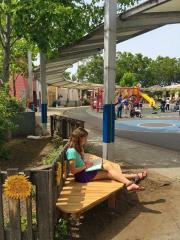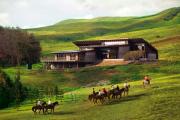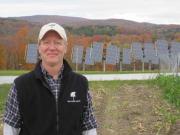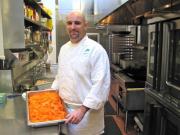Hawaii Green: Reports from the Field
Hawaii Green: Reports from the Field
My week in Hawaii enabled me to see firsthand the work of five schools engaged in environmental sustainability. Here are their stories; the first three are private-independent schools, Punahou School, La Pietra-Hawaii School for Girls, and Hawaii Preparatory Academy; the two others are public schools, Palolo Elementary School, and Ewa Makai Middle School.
1. Punahou’s Public Purpose: Systemic Leadership for Sustainability
In the fall of 2005, President Jim Scott convened a five-day Sustainability Summit at Punahou to “deepen and broaden our commitment to social and environmental sustainability.” The gathering of forty faculty, administrators, staff students, trustees and parents produced a new vision for Punahou: “to model and promote a sustainable educational community and to educate our students for a sustainable future not only through institutional action but also through individual choices.”  Founded in 1841 on the grounds surrounding “Ka punahou,” or “the new spring,” Punahou is the nation’s largest K – 12 independent school on a single campus, and with 3,750 students it resembles a small liberal arts college, with stunning views of Honolulu and the Pacific Ocean from its hillside location. The fusion of “place, people and purpose” in 2005 has led to powerful, systemic changes at Punahou.
Founded in 1841 on the grounds surrounding “Ka punahou,” or “the new spring,” Punahou is the nation’s largest K – 12 independent school on a single campus, and with 3,750 students it resembles a small liberal arts college, with stunning views of Honolulu and the Pacific Ocean from its hillside location. The fusion of “place, people and purpose” in 2005 has led to powerful, systemic changes at Punahou.
Jim Scott’s leadership has been instrumental in shaping the new direction. Raised on O‘ahu and educated at Punahou, his “island experience” made him aware of the fragile Hawaiian ecosystem.  Years later, after degrees from Stanford and Harvard, he headed the Catlin Gable School in Portland, Oregon, where he saw the powerful impact of the school’s environmental program--outdoor education class trips, five-day senior projects in the wilderness, and a new A.P. Environmental Science elective course. Punahou’s Sustainability Summit produced the 2016 Challenge, a detailed plan to reduce energy, waste, water and transportation, and to provide students with healthier, locally produced food. The Punahou Sustainability Initiative declares that “to promote a sustainable community, we will educate and learn through curricular innovation, institutional action and commitment to responsible behavioral change.” With its new focus, Punahou has moved ahead vigorously to promote a new ethic of sustainability for its students.
Years later, after degrees from Stanford and Harvard, he headed the Catlin Gable School in Portland, Oregon, where he saw the powerful impact of the school’s environmental program--outdoor education class trips, five-day senior projects in the wilderness, and a new A.P. Environmental Science elective course. Punahou’s Sustainability Summit produced the 2016 Challenge, a detailed plan to reduce energy, waste, water and transportation, and to provide students with healthier, locally produced food. The Punahou Sustainability Initiative declares that “to promote a sustainable community, we will educate and learn through curricular innovation, institutional action and commitment to responsible behavioral change.” With its new focus, Punahou has moved ahead vigorously to promote a new ethic of sustainability for its students.
Two bold Punahou building projects capture the new spirit. Just after the new century dawned, the Board of Trustees considered creating a new Middle School campus and the question of pursuing the new Leadership in Energy and Environmental Design (LEED) certification sparked a debate as it was estimated to cost 5-10 percent more. After they studied the new LEED Platinum Bren School of Environmental Science and Management at UC Santa Barbara (2002), Punahou trustee and America Online co-founder Steve Case ’75 and his siblings decided to provide funding for a complex of green buildings that would be a “beacon for the world.”  Touring this nine-building, 4.5-acre, 1,000-student LEED Gold campus with Director of Physical Plant Randy Overton, it was easy to see why the facility provides a powerful example of a sustainable, built environment. Only the 36th LEED Gold school at the time of its opening in 2005, the Case Middle School features an energy-efficient design that captures the trade winds for natural ventilation and the sun for photovoltaic power. The buildings utilize low E windows, skylights, “daylight shelves” to reflect light, individual classroom light monitors, waterless urinals, self-sealing floors that require little maintenance, rainwater catchment barrels, a water catchment systems that captures 20,000 gallons of water a day from the school’s natural spring, and recycled and Forest-Certified Materials. With the building’s completion the school introduced a composting system that recycles 100 percent of green waste for the school’s 28 gardens. Importantly, Randy Overton believes LEED is not only “the right thing to do, it saves money.” By his calculation according to the Energy Star Portfolio Manager analysis, the building is 42 percent more efficient than the norm, enabling Punahou to recoup the additional costs for LEED in 6 or 7 years. Over the projected 50-year-plus lifetime of the $56.7 million building complex, he estimates the operational cost savings will recoup much of this initial investment.
Touring this nine-building, 4.5-acre, 1,000-student LEED Gold campus with Director of Physical Plant Randy Overton, it was easy to see why the facility provides a powerful example of a sustainable, built environment. Only the 36th LEED Gold school at the time of its opening in 2005, the Case Middle School features an energy-efficient design that captures the trade winds for natural ventilation and the sun for photovoltaic power. The buildings utilize low E windows, skylights, “daylight shelves” to reflect light, individual classroom light monitors, waterless urinals, self-sealing floors that require little maintenance, rainwater catchment barrels, a water catchment systems that captures 20,000 gallons of water a day from the school’s natural spring, and recycled and Forest-Certified Materials. With the building’s completion the school introduced a composting system that recycles 100 percent of green waste for the school’s 28 gardens. Importantly, Randy Overton believes LEED is not only “the right thing to do, it saves money.” By his calculation according to the Energy Star Portfolio Manager analysis, the building is 42 percent more efficient than the norm, enabling Punahou to recoup the additional costs for LEED in 6 or 7 years. Over the projected 50-year-plus lifetime of the $56.7 million building complex, he estimates the operational cost savings will recoup much of this initial investment.
With the Case Middle School complete, it seemed only natural to use the best environmental standards for the new, $26 million, 300-student, LEED Platinum elementary school complex, which opened in 2010. Called the Omidyar K-1 Neighborhood, and named for alumnus Pierre Omidyar ’84, founder of the Internet auction site eBay, the buildings feature natural lighting, solar PV power, and energy efficiency that students study real-time on the Lucid Design Building Dashboard.  Touring the new facility with Junior School Principal Mike Walker, it was evident that the building was designed to support the students’ development as environmental stewards.
Touring the new facility with Junior School Principal Mike Walker, it was evident that the building was designed to support the students’ development as environmental stewards.  We watched three boys eagerly explore the bioswale, a young girl scoop up dirt in her hands to haul up to the base of the new windmill, and a class of kindergartners swarm a garden box to clear it of vegetation and prepare it for new seeding. The curriculum has been reshaped to incorporate environmental themes, inspired by The Last Child in the Woods and the latest in brain-based research that demonstrates the power of nature to refresh the mind. Emblematic of the curricular efforts, the faculty and students designed and built a beautiful mosaic for the new campus, an interdisciplinary project that evokes the ancient Hawaiian conservation systems.
We watched three boys eagerly explore the bioswale, a young girl scoop up dirt in her hands to haul up to the base of the new windmill, and a class of kindergartners swarm a garden box to clear it of vegetation and prepare it for new seeding. The curriculum has been reshaped to incorporate environmental themes, inspired by The Last Child in the Woods and the latest in brain-based research that demonstrates the power of nature to refresh the mind. Emblematic of the curricular efforts, the faculty and students designed and built a beautiful mosaic for the new campus, an interdisciplinary project that evokes the ancient Hawaiian conservation systems.  From the K-1 program, all the way up to the senior year, the faculty has mapped salient features of the evolving environmental sustainability curriculum.
From the K-1 program, all the way up to the senior year, the faculty has mapped salient features of the evolving environmental sustainability curriculum.
The focus on student leadership is especially evident at the Luke Center for Public Service, directed by Carri Morgan and Assistant Director Terry Yamamoto-Edwards. Together they lead this special program that annually trains 150 student leaders, supports the school’s Green Team, and offers an annual teachers’ institute, which focused in October 2011 on the theme, “Can You Be Plastic Free?” I met with three high school Green Team leaders—Jennifer Bryan, Hannah Broaderick, and Emily Jampel—who are heading up a special initiative to change student behavior.  After eliminating soft drinks following a review by food consultant Ann Cooper, the school focused on the significant, unanticipated problem of plastic water bottles. Analyzing the school’s operations, the students determined that Punahou generates about 240,000 disposable bottles a year. They have made a presentation to the school’s head of operations, planned a series of student assemblies, and proposed new BYOB (Bring Your Own Bottle) water filtration equipment. For these leaders, the Luke Center gives them a real opportunity to make a difference.
After eliminating soft drinks following a review by food consultant Ann Cooper, the school focused on the significant, unanticipated problem of plastic water bottles. Analyzing the school’s operations, the students determined that Punahou generates about 240,000 disposable bottles a year. They have made a presentation to the school’s head of operations, planned a series of student assemblies, and proposed new BYOB (Bring Your Own Bottle) water filtration equipment. For these leaders, the Luke Center gives them a real opportunity to make a difference.
Punahou has long been known for its commitment as a private school with a public purpose. The Luke Center, the Wo International Center, and the PUEO Program for public Middle School youth with high academic potential and low economic opportunity are examples of the school’s broad-based initiatives. The Punahou Sustainability Initiative models this effort to build a better future, for the school and the wider community. As the 2016 Challenge asks everyone, “Are you choosing a sustainable future?” For Punahou, the answer is yes!
2. La Pietra: An Emerging Green School
When visiting La Pietra-Hawaii School for Girls in January as part of their regular accreditation process, I discovered a school that is developing a new, green consciousness.  Every school engaged in shaping a commitment to environmental sustainability takes a different path. For La Pietra, the journey has been greatly influenced by the school’s profoundly beautiful setting.
Every school engaged in shaping a commitment to environmental sustainability takes a different path. For La Pietra, the journey has been greatly influenced by the school’s profoundly beautiful setting.
Founded in 1964, La Pietra-Hawaii School for Girls is an independent, 6-12 college-preparatory day school with 200 students located on a five-acre campus on the slope of the ancient volcano Diamond Head and adjacent to its surrounding parkland.  The main building occupies the former Dillingham estate, the residence of a successful Hawaiian real estate investor who had the structure built with stone imported from Italy. The solid construction provides natural insulation against the heat, and tall doors and windows allow the prevailing winds to maintain a constant, comfortable temperature. The campus has been developed over the years and the additional five main classroom buildings take advantage of the appealing climate, with natural light and ventilation.
The main building occupies the former Dillingham estate, the residence of a successful Hawaiian real estate investor who had the structure built with stone imported from Italy. The solid construction provides natural insulation against the heat, and tall doors and windows allow the prevailing winds to maintain a constant, comfortable temperature. The campus has been developed over the years and the additional five main classroom buildings take advantage of the appealing climate, with natural light and ventilation.
The spacious grounds, filled with beautiful plantings, dotted with arching shade trees, and offering spectacular views of the Pacific Ocean give students immediate access to the outdoors for study, recreation, and reflection.  La Pietra’s Head of School for the last five years, Mahina Hugo, who has been at the school for nearly two decades, has drawn on her interest in gardening and the environment to ensure regular upkeep of the grounds and to create a “founders’ garden” that is filled with native Hawaiian plants. The school also takes advantage of its location at the east end of Waikiki to use the nearby Kapiolani Park and Kaimana Beach for classes ranging from physical education to marine biology.
La Pietra’s Head of School for the last five years, Mahina Hugo, who has been at the school for nearly two decades, has drawn on her interest in gardening and the environment to ensure regular upkeep of the grounds and to create a “founders’ garden” that is filled with native Hawaiian plants. The school also takes advantage of its location at the east end of Waikiki to use the nearby Kapiolani Park and Kaimana Beach for classes ranging from physical education to marine biology.
Throughout my four-day visit, it became apparent that the Head of School, her administrative team, faculty, students, and the long-time Director of Finance Ed Keyes are beginning to take steps to green the school. In the near future they will evaluate the school’s facilities and operations to ensure that they promote environmental sustainability, through energy efficiency, healthy campus operations, and nutritious food. A comprehensive energy audit is being considered to assist in adopting further efficiencies, and the students are engaged in helping to run the recycling program. In earlier era the school made use of its two kitchens and may well consider restoring them to use to provide local, fresh and seasonal meals to the students.
In the near future they will evaluate the school’s facilities and operations to ensure that they promote environmental sustainability, through energy efficiency, healthy campus operations, and nutritious food. A comprehensive energy audit is being considered to assist in adopting further efficiencies, and the students are engaged in helping to run the recycling program. In earlier era the school made use of its two kitchens and may well consider restoring them to use to provide local, fresh and seasonal meals to the students.  The grounds also offer ample opportunity to create a vermiculture composting program for all the organic waste and a garden to help the girls appreciate where our food comes from, a goal well articulated by the new Grow Hawaii movement. For faculty like Jessica Takei, who teaches Middle School physical science, there is also opportunity to incorporate environmental themes in the curriculum.
The grounds also offer ample opportunity to create a vermiculture composting program for all the organic waste and a garden to help the girls appreciate where our food comes from, a goal well articulated by the new Grow Hawaii movement. For faculty like Jessica Takei, who teaches Middle School physical science, there is also opportunity to incorporate environmental themes in the curriculum.
All across Hawaii, and around the globe, schools are growing greener. It is important to realize there is no one best way to make this happen. By identifying the school’s natural assets, and focusing on five key areas—energy efficiency, healthy operations, environmental literacy in the curriculum, nutritious food, and student leadership—all schools can make a difference.
3. Hawaii Preparatory Academy: Energizing 21st Century Education
Hawaii Preparatory Academy, a K-12, two-campus, boarding-day school of 600 students founded in 1949 on the Big Island of Hawaii, is at the forefront of a dramatic transformation underway in creating educational facilities and programs that prepare students for this new century.  While I was not able to visit the campus in my trip to Hawaii, I once again conducted a “virtual tour” of the school, on the fully developed website (www.hpa.edu) and through conversations with Head of School Lindsay Barnes and Director of the HPA Energy Lab, Dr. Bill Wiecking.
While I was not able to visit the campus in my trip to Hawaii, I once again conducted a “virtual tour” of the school, on the fully developed website (www.hpa.edu) and through conversations with Head of School Lindsay Barnes and Director of the HPA Energy Lab, Dr. Bill Wiecking.
In the spring of 2006 a Go Green effort had begun at HPA, and the next year the school convened a charrette--a gathering of parents, teachers, administrators, students and design professional--to consider a vision for the school’s sustainability. The group broke into four groups to explore energy, recycling, transportation, and water. For some years, physics teacher Bill Wiecking had been using the campus energy use as an object lesson for his students, designing lessons that had them evaluate the school’s performance and recommend solutions. His group covered a wall with post-its describing a new science building that models best practices in 21st century learning that helps students develop critical, creative, real-world problem solving skills.  The idea for an “energy lab” was born that day. A parent participant offered to fund the project. Three years later, in January 2010, HPA open its new Energy Lab, a remarkable new facility.
The idea for an “energy lab” was born that day. A parent participant offered to fund the project. Three years later, in January 2010, HPA open its new Energy Lab, a remarkable new facility.
Designed with student input for student use and education, the Energy Lab is a 6100 square foot, $3.7 million facility that is certified LEED Platinum 2.0 for Schools and has achieved the even higher standard of the Living Building Challenge. The building is one of the first Zero Net Energy high school buildings in the country, generating more energy than it consumes, principally from a large photovoltaic solar array. Students monitor the building’s energy use, the energy use on the rest of the campus, and even at facilities in the surrounding community as part of an effort to engage them in identifying and presenting solutions to drive efficiency. 
The Energy Lab design features many innovative approaches to sustainable building design. The site itself is terraced to provide a field station for biofuel research and is positioned to take advantage of the prevailing, mauka (mountainside) winds that cool the building through a series of window louvers. The energy and carbon dioxide use is monitored with sensors that are tracked in a special Monitoring Room. Water use is rigorously controlled, with dual flush toilets, a freshwater catchment system, and conservation behavior that keeps the total building use to 11 gallons a day.  The materials used in construction include Forest Stewardship Certified (FSC) and recycled wood. And consistent building temperature is maintained by a radiant cooling system that includes an insulated tank that collects cooled water at night, which is pumped to roof-top panels during the day and which radiates heat out into space. Healthy air quality throughout the building also is monitored by CO2 sensors. In the words of the students, the Energy Lab is “the cathedral of the future,” an environment ideally suited for learning.
The materials used in construction include Forest Stewardship Certified (FSC) and recycled wood. And consistent building temperature is maintained by a radiant cooling system that includes an insulated tank that collects cooled water at night, which is pumped to roof-top panels during the day and which radiates heat out into space. Healthy air quality throughout the building also is monitored by CO2 sensors. In the words of the students, the Energy Lab is “the cathedral of the future,” an environment ideally suited for learning.
HPA recognized early its sustainability journey that a systems effort is critical to success. In addition to the revolutionary construction design of the Energy Lab, the campus is focused on healthy operations including a recycling and composting program. The educational program ensures that students are developing leadership skills as they become global citizens. The week before I visited, Bill Wiecking took a team of students to the MacWorld conference, and then visited the Jasper Ridge biological preserve at Stanford, which is partnering with HPA to adopt its approach to energy monitoring and efficiency. The school has also created Hoku a Aina, a global sustainability curriculum and the Student Congress for Sustainability to offer training to students and faculty from other schools. Finally, the school’s garden program and effort to provide food that is fresh, local and organic is part of the HPA participation in the Hawaii Island School Garden Network run by the Kohala Center.
Inspired leadership has been critical to the HPA success. Bill Wiecking himself is passionate about environmental sustainability. He has taught at a number of independent schools, including Punahou and La Pietra and has worked for the Maui supercomputer center. A UC Berkeley physics graduate, he received an M.A. from the University of Hawaii and a Ph.D. in neuroscience from the University of Hawaii Medical School.
Head of School Lindsay Barnes, who himself has a J.D and practiced law for many years, shares the passion for sustainability.  Raised in Virginia, he was serving as headmaster of the Miller School of Albemarle in Charlottesville when he developed a “conservation ethic” trying to save on energy costs at his 125 year-old boarding school. Coming from Virginia in 2008, where the “sustainability movement was in its infancy,” he quips that he quickly discovered that Hawaii is “on top of ‘greenology’!” For him, the school’s Energy Lab is an “instructional facility where students can learn about the functional imperatives of a post-Age of Petroleum world” and prepare to become “leaders of their generation.” To that end, he is proud of HPA’s role in hosting three summer student sustainability conferences and hopes that the Energy Lab can support the development of a network of green schools that can have a “worldwide impact.”
Raised in Virginia, he was serving as headmaster of the Miller School of Albemarle in Charlottesville when he developed a “conservation ethic” trying to save on energy costs at his 125 year-old boarding school. Coming from Virginia in 2008, where the “sustainability movement was in its infancy,” he quips that he quickly discovered that Hawaii is “on top of ‘greenology’!” For him, the school’s Energy Lab is an “instructional facility where students can learn about the functional imperatives of a post-Age of Petroleum world” and prepare to become “leaders of their generation.” To that end, he is proud of HPA’s role in hosting three summer student sustainability conferences and hopes that the Energy Lab can support the development of a network of green schools that can have a “worldwide impact.”
HPA has seen the future. With a concerted effort to develop new strategic, master, financial and energy plans, the school intends to reshape its educational facilities and programs to promote environmental sustainability. With HPA’s success, the future of green schools will be a bright one.
4. Palolo Elementary School: From Last to Green
When Ruth Silberstein became principal of the Palolo Elementary School in Honolulu, she knew she had taken on a major challenge.  A nineteen-year veteran principal who had headed two other Hawaiian public schools, she agreed to take on the leadership of one of the state’s worst performing elementary schools. In 2002, only 11% of the students tested proficient on the state’s reading exam, and only 1% on mathematics. The direction the school needed to take was clear.
A nineteen-year veteran principal who had headed two other Hawaiian public schools, she agreed to take on the leadership of one of the state’s worst performing elementary schools. In 2002, only 11% of the students tested proficient on the state’s reading exam, and only 1% on mathematics. The direction the school needed to take was clear.
Founded in the 1920s to education 700 children, Palolo today enrolls 280 students who come mainly from poor, immigrant families. Over 95% of the students qualify for free and reduced lunch based on household income, nearly 60% are immigrants, and they represent 18 different racial, ethnic and national groups. While we know that test score performance is strongly influenced by socio-economic status, by any measure the Palolo students were failing at school.
As Silberstein recalls, the school went through a “restructuring” process in her first few years as principal. A standards-based testing and accountability system was introduced with the implementation of the No Child Left Behind national legislation in 2002. While NCLB has been the subject of sharp debate in recent years, at Palolo it contributed to a transformation of the school. 
According to Britt Britton, vice-president of educational services at Edison, she and a team of “achievement consultants” have worked with the school’s faculty and administration over a seven-year period, beginning with comprehensive support for two years followed by periodic assistance since then. They changed the focus from teacher-directed learning to a 21st century educational culture that emphasizes collaborative student learning that is transparent.  Using the state’s subject based standards, they coached teachers on how to prepare lessons that would give students measurable skills, and introduced a system of regular assessments that are published for all in the community to review. For each student, the teachers maintain detailed records to track performance progress. And students are given responsibility for their own learning, as they also coach other students, lead their parent-teacher conferences, and serve as ambassadors for any community visitors. The progress at Palolo Elementary could not have been more dramatic. By the 2007-08 school years, student test score performance had reached nearly the 50th percentile in reading and math.
Using the state’s subject based standards, they coached teachers on how to prepare lessons that would give students measurable skills, and introduced a system of regular assessments that are published for all in the community to review. For each student, the teachers maintain detailed records to track performance progress. And students are given responsibility for their own learning, as they also coach other students, lead their parent-teacher conferences, and serve as ambassadors for any community visitors. The progress at Palolo Elementary could not have been more dramatic. By the 2007-08 school years, student test score performance had reached nearly the 50th percentile in reading and math.
At this critical moment, Ruth Silberstein decided to launch a bold initiative and take the school in an important new direction. In April 2008, the staff of Palolo, like many faculties around the nation, was “in deep awareness of the increasing global problem and challenges facing life on earth.” Accordingly, they declared that Palolo Elementary would adopt the theme of “Sustainability and S.T.E.M. (Science, Technology, Engineering & Math). Already addressing the standards through the core curriculum, the faculty changed the educational pedagogy, the “how,” to a place-based, problem-solving curriculum.
To implement the program, the staff and students brainstormed a list of global issues, and each grade decided on a theme and interdisciplinary approach.  Guided by Joyce Luka, the Science Coordinator, the Kindergarten would study rainforests, and the others declared a focus as follows: First, Pollution; Second, Recycling; Third, Sustainability; Fourth, Aquaponics; and Fifth, Alternative Energy/Underwater Robots. With intensive professional development, the faculty developed a series of interdisciplinary units that were closely tied to state standards. And in the 2010-11 school year, the new curriculum was up and running.
Guided by Joyce Luka, the Science Coordinator, the Kindergarten would study rainforests, and the others declared a focus as follows: First, Pollution; Second, Recycling; Third, Sustainability; Fourth, Aquaponics; and Fifth, Alternative Energy/Underwater Robots. With intensive professional development, the faculty developed a series of interdisciplinary units that were closely tied to state standards. And in the 2010-11 school year, the new curriculum was up and running.
Visiting Palolo Elementary I could see first hand the results of greening the school. The Kindergarten and parent volunteers had just completed planting a small rainforest on campus, to make something that is very far away very real for the youngest students.  Recycling and composting operations are in full swing. The Third Grade garden, with its vermacast composting system, gives students a laboratory to test hypothesis and learn the scientific method. The Fourth Grade aquaponics study focuses on medicinal plants, which has incorporates the cultural experience of the immigrant families. The Fifth Grade caps the program by studying global warming and alternate energy.
Recycling and composting operations are in full swing. The Third Grade garden, with its vermacast composting system, gives students a laboratory to test hypothesis and learn the scientific method. The Fourth Grade aquaponics study focuses on medicinal plants, which has incorporates the cultural experience of the immigrant families. The Fifth Grade caps the program by studying global warming and alternate energy.
It is clear that the students of Palolo Elementary are gaining a real world, 21st century education and becoming young environmental stewards. What is amazing is to see what happened to their test scores since the new curriculum was implemented; in 2011 student performance in reading reached 67%, and in math an extraordinary 83%. When she herself was in Middle School, Ruth Silberstein wanted to become a doctor to save lives. Instead, she became a principal. Little did she know she would be saving lives.
5. Ewa Makai Middle School: LEEDing the Way
Hawaii’s first LEED gold school, the Ewa Makai Middle School, which opened in January 2011,  is a stunning educational facility, a $64.8 million, 202,409 square foot building that features state-of-the-art design to promote environmental sustainability.
is a stunning educational facility, a $64.8 million, 202,409 square foot building that features state-of-the-art design to promote environmental sustainability.
The school site features the best practices in sustainable design, including: large, spacious classrooms; wide and airy hallways; natural lighting with solar tubes, light shelves and skylights; an air-conditioning system that circulates ample fresh air; a storm water retention system; grey-water irrigation and low-flow plumbing; and occupancy sensors to reduce electricity demand. Further, Ewa Makai is fully wired and supported by a technology infrastructure that can support the creation of a 21st century school. The Department of Education estimates that the LEED features will save $22,000 a year. (“Ewa Makai Middle School: Planning the School of Tomorrow,” Hawaii Department of Education)  As the assistant superintendent of the Department of Education, Randal Moore, proudly observed, “Ewa Makai’s Gold LEED designation sets a new standard for green school design in Hawaii.” (Ewa Makai’s Green Design Achieves ‘Gold’ Certification, Hawaii Department of Education, November 18, 2011)
As the assistant superintendent of the Department of Education, Randal Moore, proudly observed, “Ewa Makai’s Gold LEED designation sets a new standard for green school design in Hawaii.” (Ewa Makai’s Green Design Achieves ‘Gold’ Certification, Hawaii Department of Education, November 18, 2011)
As in any effective school, the heart can be found in inspired leadership. Principal Ed Oshiro was leading Aiea Elementary School through a successful restructuring process when he was called to head the new Ewa Makai Middle School; he jumped at this once-in-a-lifetime chance to put his stamp on the culture of a start up. With a broad smile, a gentle manner, and a love of people, Ed Oshiro sets a high standard for Ewa Makai to become “the best school in Hawaii.” 
As a scholarship student at the private-independent Iolani School in Honolulu, he says, he learned the value of a fine education and has devoted his career to public school students who deserve the very best. It was a pleasure to meet his inspired team who are helping him shape the culture of the new school: Jordan Higa joined him early on to build the advanced technology program, Ursula Kawaguchi serves as his vice-principal, Vanessa Kealoha runs the student activities, leadership development program, and green initiatives, and David Wong has come from an inner-city high school to learn the art of motivating middle school youth. When I asked why a green school makes sense, they quickly chimed in: “It integrates the curriculum, it promotes whole child philosophy, it enables the school to leverage sustainable practices for the community.” As David Wong observed, “We teach 110%: spending 100% of our time offering a program to meet state standards, and another 10% making this a green school focused on sustainability and project based learning.”
Ewa Makai has put kids first, as was evident when we met with, Justyn Golobic and Daylin Kuboyama, two eighth grade members of the Leadership Team, a group of a fifteen students selected to guide the student activities and green initiatives at the school, currently with 770 students in grades seven and eight. Confidently striding into the conference room, they proceeded to present their PowerPoint on Ewa Makai Green Initiatives.  With knowledge and skill, they rattled off the many programs: vermicast and Soldier Fly larvae composting; school wide recycling that nets a profit for the student body; a student garden constructed with recycled materials; an organic garden that provides produce to the cafeteria;
With knowledge and skill, they rattled off the many programs: vermicast and Soldier Fly larvae composting; school wide recycling that nets a profit for the student body; a student garden constructed with recycled materials; an organic garden that provides produce to the cafeteria;  an “aquaponics” production operation that combines fish raising and organic vegetable production; and the adoption of the “less paper classroom” that features wide use of SMART Boards, PowerPoint slideshows, email, ebooks, laptops and iPads. Capping off their presentation, they screened a student-produced video about their school that conveyed pride and a real sense of accomplishment.
an “aquaponics” production operation that combines fish raising and organic vegetable production; and the adoption of the “less paper classroom” that features wide use of SMART Boards, PowerPoint slideshows, email, ebooks, laptops and iPads. Capping off their presentation, they screened a student-produced video about their school that conveyed pride and a real sense of accomplishment.
People often ask if greening a school makes a difference for students. At Ewa Makai it seems clear that the students enjoy learning in their spacious, beautiful, well-lighted environment, and they convey a sense of pride and hope for the future.  Because of his experience at Ewa Makai, Justyn told us he intends to become a lawyer to fight for environmental justice. Daylin said she wanted to become a green ambassador to help other schools become like hers. After my visit, Daylin wrote an extended reflection on why green schools inspire her and other students:
Because of his experience at Ewa Makai, Justyn told us he intends to become a lawyer to fight for environmental justice. Daylin said she wanted to become a green ambassador to help other schools become like hers. After my visit, Daylin wrote an extended reflection on why green schools inspire her and other students:
“We need more opportunities to learn with hands on activities together with real world situations. I think students cannot be well rounded by learning with only textbooks and worksheets! We need to develop students who are risk takers and innovators who also care about others, their school and community! Our confidence is also boosted because we realize that as individuals we can make a difference in the world. Doing these green initiatives does not take away from students' academic success, but instead gives them the motivation to continue to strive for excellence and most of all, change!”
In a school that is LEEDing the way in sustainable design, it was inspiring to meet students and staff who are confident that they are making a difference and contributing to a more sustainable world.








